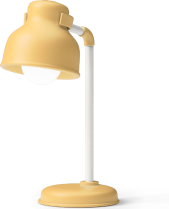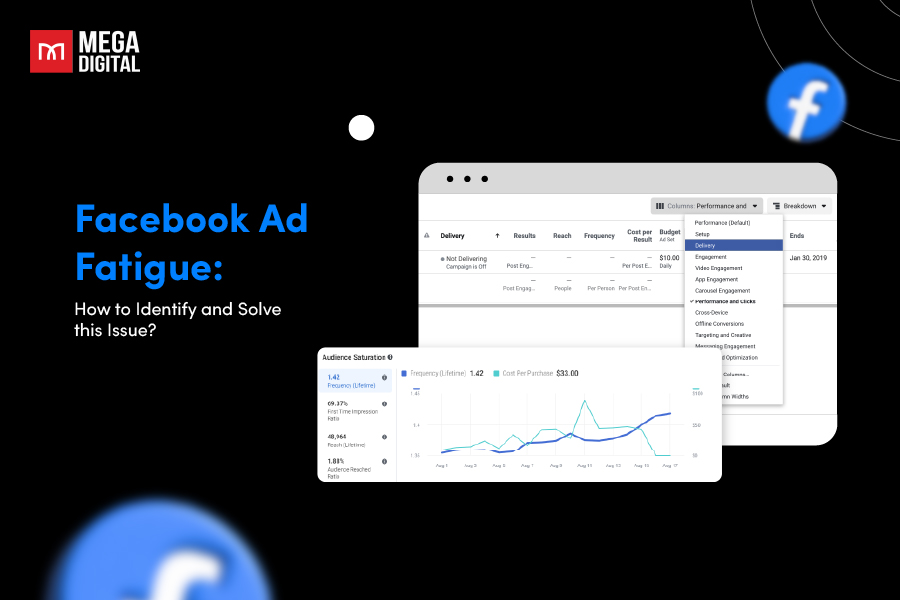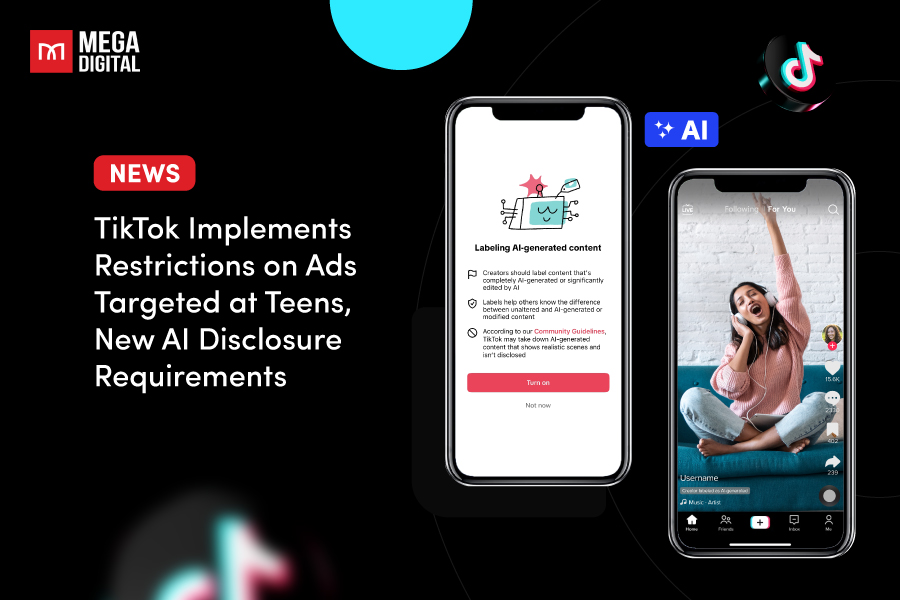Dropshipping has intrigued entrepreneurs for years. As we enter 2025, the burning question persists: is dropshipping profitable? Let’s dissect this topic step by step, peeling back the layers of expectations, revealing the sometimes harsh realities, and finding out Mega Digital’s forecasted profit margins for certain niches in 2025.
Contents
Is Dropshipping Still Popular in 2025?
The answer is yes—dropshipping is very much alive and thriving in 2025. According to Statista, the global dropshipping market is projected to reach $372.47 billion this year, and dropshipping continues to be one of the most accessible ways to participate in the booming e-commerce industry.
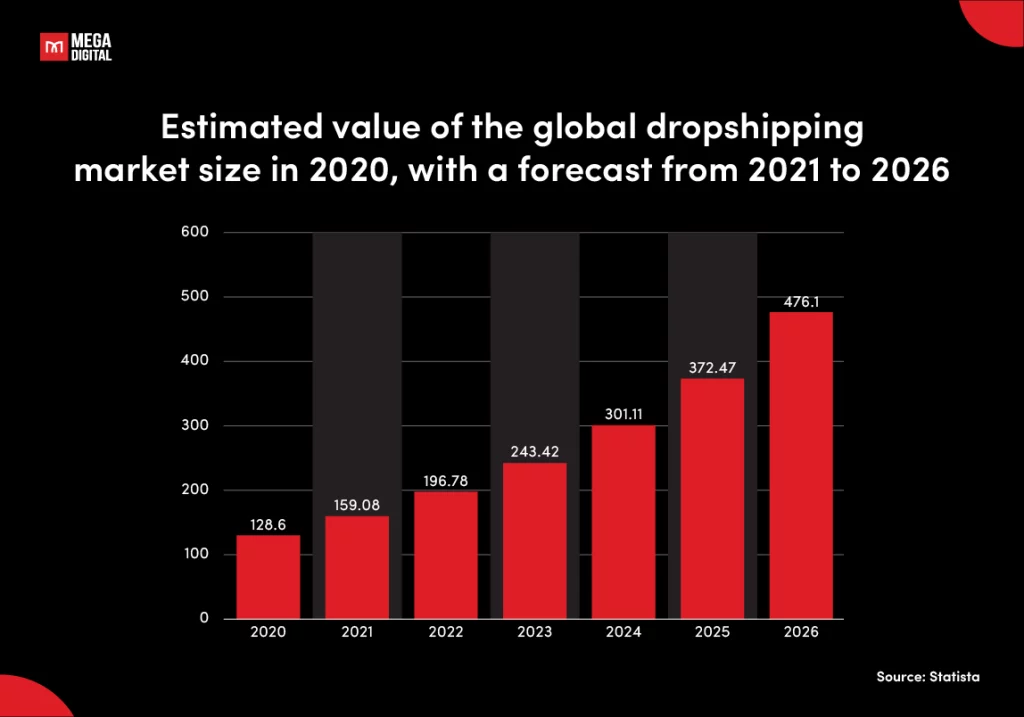
Plus, the best platforms for dropshipping like Shopify, WooCommerce, BigCommerce, and numerous robust tools serving different purposes make it easier than ever to launch an online store.
However, the game has changed. It’s no longer about setting up a generic store and hoping for the best. Today’s customers expect fast shipping, personalized experiences, and high-quality products. To succeed in dropshipping now, you need to specialize in a niche, build a strong brand, and invest in customer satisfaction.
Dropshipping Fundamental Costs
To understand if dropshipping is profitable, you need to grasp the fundamental costs associated with running a dropshipping business. Let’s break them down one by one.
E-Commerce Platform Costs
You’ll first need a platform like Shopify or WooCommerce to build your online store. These platforms provide templates, payment integrations, and essential tools to run your store.
- Shopify plans range from $29 to $299/month, depending on the features.
- WooCommerce is free, but you’ll pay for hosting (around $10–$30/month) and premium plugins.
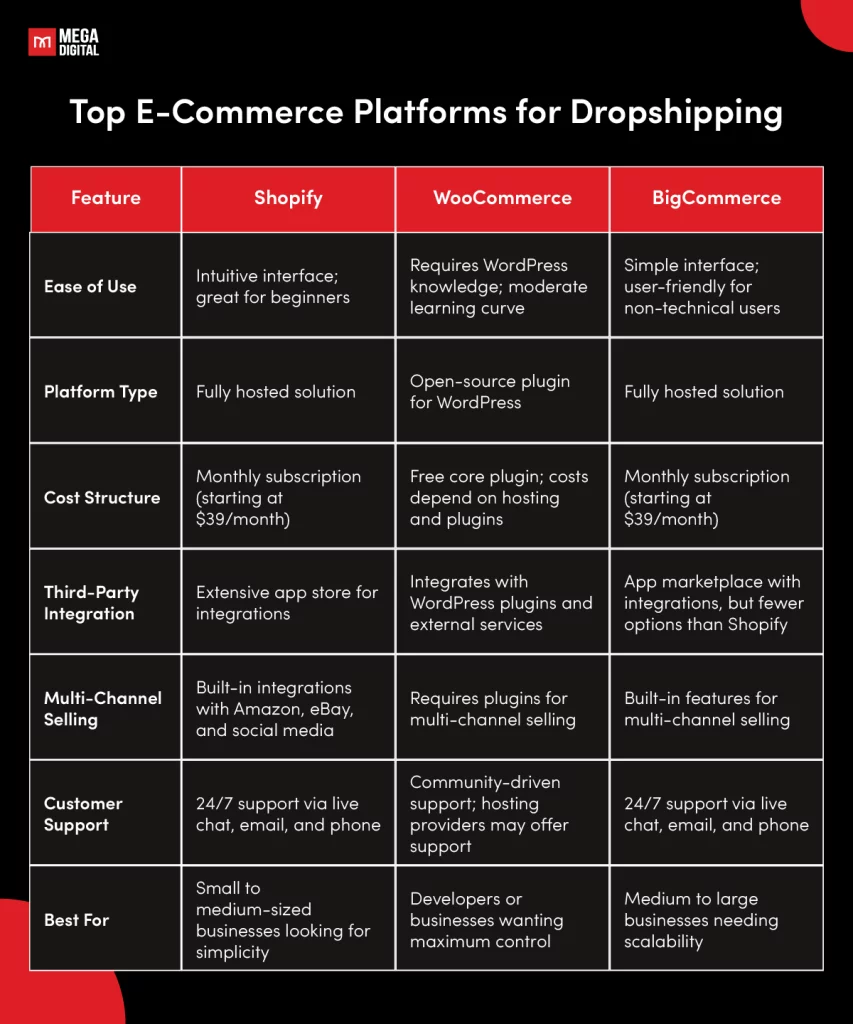
Advertising Costs
Marketing is often the largest expense in dropshipping. Without effective advertising, your store won’t attract customers.
- Facebook Ads for dropshipping: CPMs (cost per 1,000 impressions) average $15–$25 in competitive niches.
- TikTok Ads for dropshipping: Offer lower CPMs at $5–$10, making them a cost-effective option for reaching younger audiences.
- Google Ads and influencer marketing are additional options, with costs varying by industry.
Generally speaking, to test and scale campaigns, you’ll need an advertising budget of $500–$5,000/month.
@shopdealsbyjm Why was he skeeping for 14 HOURS!!!! #skit #blanket #ad #product #fyp #tiktokmademebuyit #cold #blanketlife #tiktokshop
♬ original sound – ShopDealsByJM
Product Costs (Cost of Goods Sold)
Suppliers typically charge 30%–60% of the retail price for each product. For example, if you sell a $50 product, you can expect to pay between $15 and $30 to your supplier.
Remember to account for shipping fees, especially for international orders. Some suppliers charge extra for expedited shipping or bulk discounts.
Apps and Plugins
To optimize your store and improve user experience, you’ll need various apps and plugins.
- Product sourcing tools like Oberlo or Spocket range from $20–$50/month.
- Email marketing tools like Klaviyo cost $20–$200/month depending on your subscriber count.
- Upsell and cross-sell plugins can range from $10–$50/month.
These tools save time and improve efficiency, but they add to your monthly expenses.
What are the Average Profit Margins for 2025 Dropshipping?
Now, the big question: is dropshipping profitable?
On average, profit margins for dropshipping range from 10% to 30%. While the numbers might sound modest, scaling your operations and focusing on high-ticket products can lead to more significant profits.
Here’s a detailed breakdown of Mega Digital’s experts’ projected 2025 profit margins (by product category):
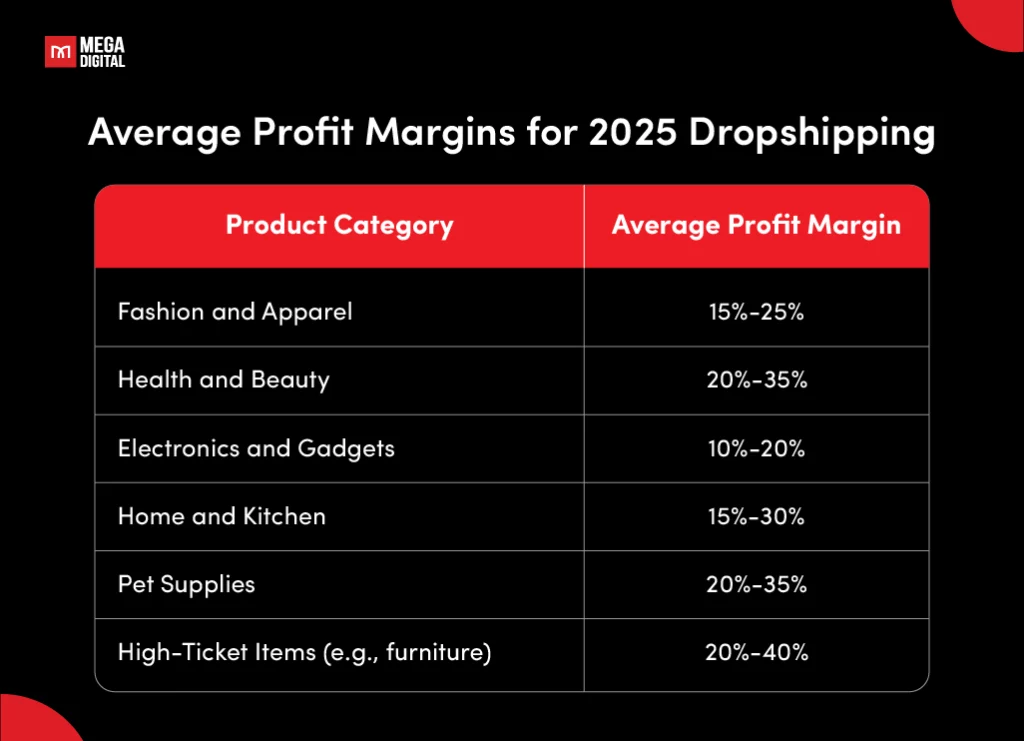
While high-ticket items like furniture may offer better margins, they require higher advertising budgets and a longer sales cycle. On the other hand, low-cost items like phone cases sell in high volumes but come with razor-thin margins.
Again, I have to put heavy emphasis on the reality here: these are only the average profit margins for reference. Failure or success depends on countless factors, and these numbers certainly do not apply to every dropshipper or every product in the same categories.
>>> Read more: How to Do Product Research for Dropshipping: 6 Best Methods
How to Run a Profitable Dropshipping Store
Running a profitable dropshipping store in 2025 requires more than setting up a website and launching ads. It’s about executing a well-thought-out strategy that combines product selection, branding, marketing, and customer service.
Having worked in the e-commerce space for years, I’ve seen what works and what doesn’t. Let me walk you through the steps to build a store that’s not just functional but genuinely profitable.
1. Find Your Niche
If you try to sell everything to everyone, you’ll end up selling nothing to anyone. Finding your best dropshipping niches—the specific audience you want to serve—is your first step to standing out in a crowded market.
How I do it:
- I use Google Trends, Niche Scraper, TikTok Creative Center, TikTok hashtags, etc. to spot trending products or themes. For example, last year, compact fitness gear and eco-friendly pet products were all the rage, and they’re still going strong.
- Look for niches with passionate communities. If people love what they’re into—whether it’s yoga, gaming, or sustainable living—they’re more likely to buy.
- Check the numbers. Tools like Ahrefs or Ubersuggest can help you see if people are actually searching for products in your niche. If there are at least 1,000 monthly searches, you’re on the right track.
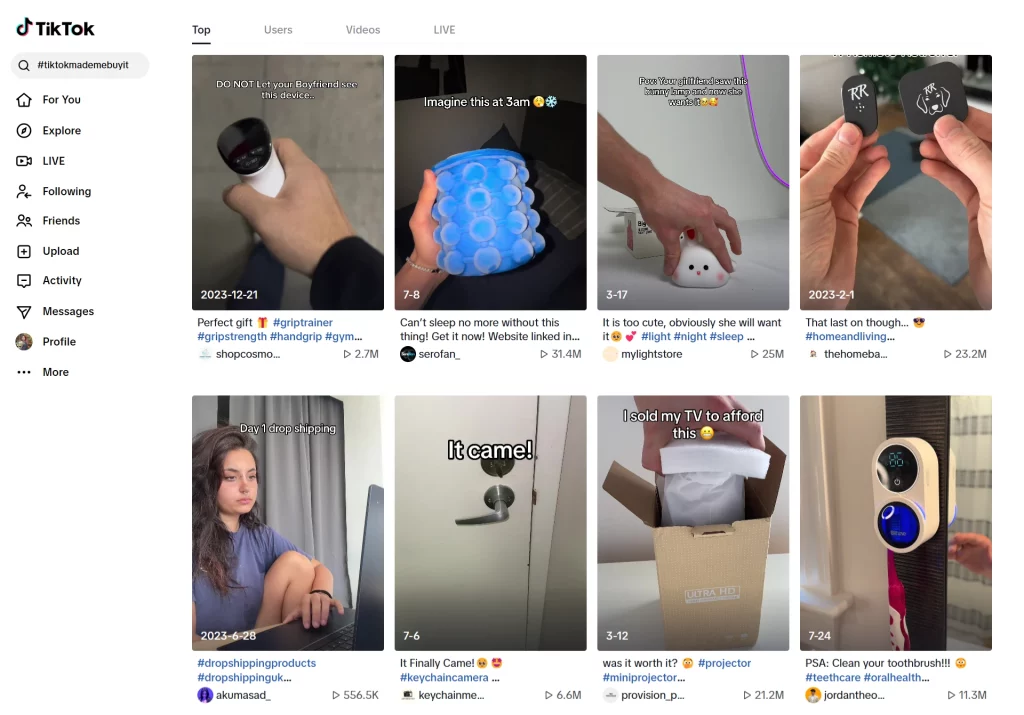
Pro Tip: Don’t overthink it. You don’t need to reinvent the wheel—just find a niche that’s in demand and align it with your interests if you can.
2. Choose Winning Products
Your products are the heart of your store. The best winning products solve problems, make life easier, or tap into something people are excited about.
How I choose products:
- I look for items with 20–30% profit margins and check platforms like Spocket or CJ Dropshipping for quality suppliers.
- Winning products should have 2–3 clear benefits. For example, I once sold foldable laptop stands because they were portable, solved posture problems, and appealed to remote workers.
- Always order samples before listing a product. It costs $20–$50, but it’s worth it to make sure the quality won’t get you into trouble with refunds or bad reviews.
Pro Tip: Look for products that make people say, “I need this!” rather than just “Oh, that’s cool.”
3. Determine the Best Dropshipping Pricing Strategy
Pricing isn’t just about covering your costs; it’s about convincing people to hit the “Buy Now” button. I’ve learned that small tweaks in pricing can make a big difference in sales.
Here’s what I recommend:
- Keystone Pricing: Double the supplier price. For example, if the product costs $20, sell it for $40.
- Psychological Pricing: Use prices like $19.99 instead of $20. It’s an old trick, but it works because people perceive it as cheaper.
- Bundle Deals: Offers like “Buy 2, Get 1 Free” can increase your average order value. People love feeling like they’re getting a deal!
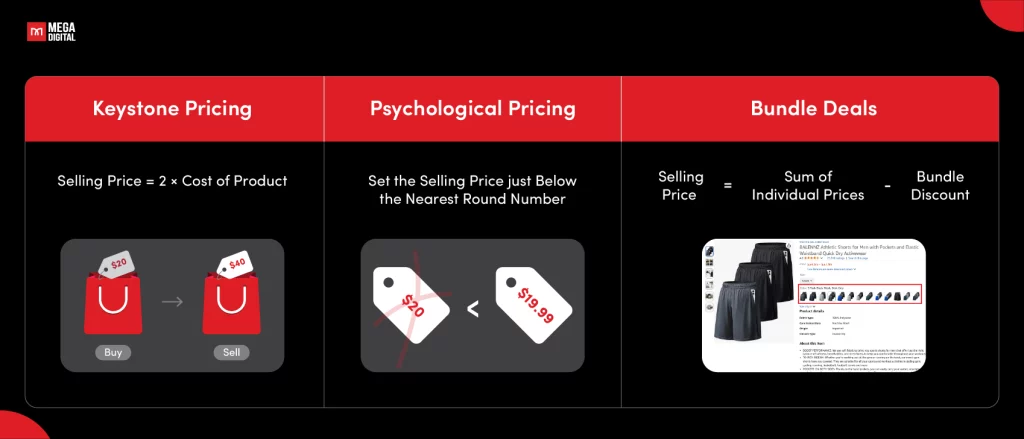
Pro Tip: Keep testing your pricing. Even small changes can have a noticeable impact on your conversion rates.
If you want to know more about dropshipping pricing and start thinking strategically instead of just guessing and estimating, check out Mega Digital’s blog, 9 Expert-Recommended Dropshipping Pricing Strategies (2025), for an in-depth guide.
4. Create a Store That Builds Trust
People buy from stores they trust. If your website looks sketchy, they’ll bounce faster than you can say “free shipping.”
What I do:
- Add customer reviews, trust badges, and clear refund policies. These small details reassure customers that you’re legit.
- Make sure your product descriptions are clear and engaging. High-quality photos and a solid call-to-action (CTA) like “Add to Cart” work wonders.
- Focus on mobile design. With over 70% of e-commerce traffic coming from mobile, your store should look amazing on a phone.
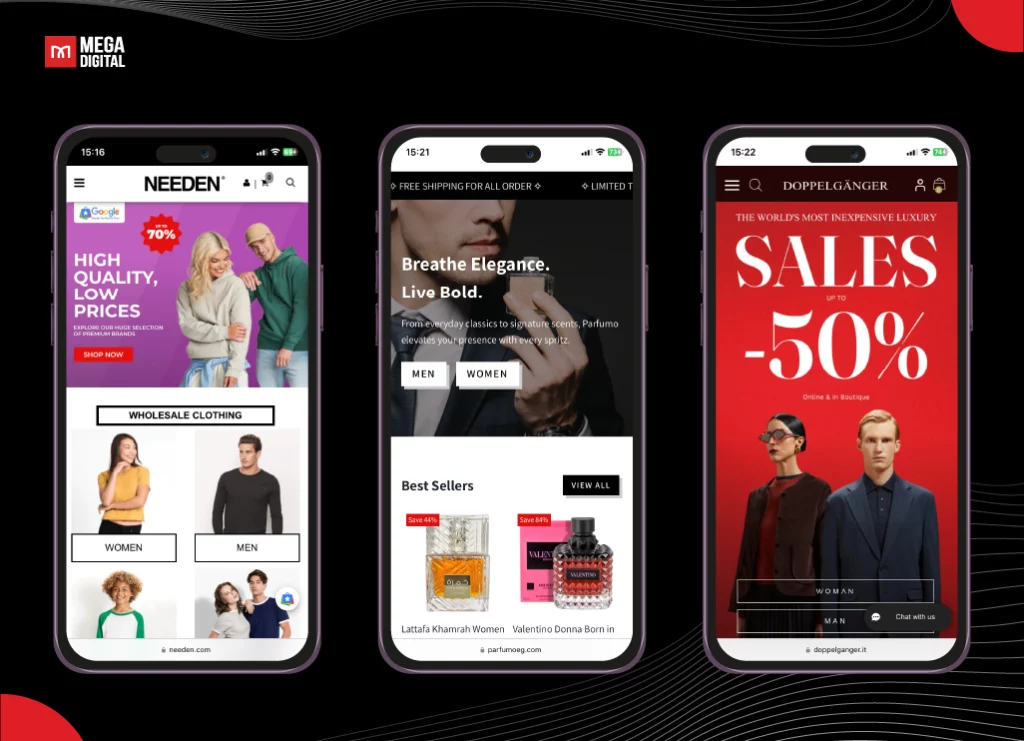
Pro Tip: I use tools like Hotjar to see how visitors interact with my site. It’s eye-opening to watch where they click—or don’t click.
Plus, platforms like Shopify and themes like Debutify are my go-tos because they’re easy to set up, provide a professional look, and are perfect if you’re new to web design.
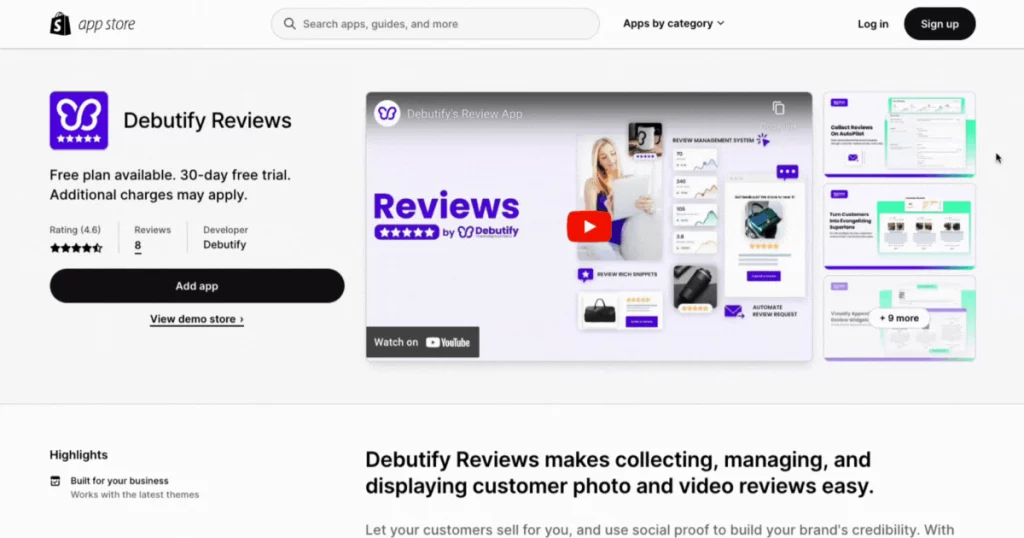
5. Market Your Store
Marketing isn’t just about ads—it’s about building relationships and trust. If you focus on creating value for your audience, they’ll be much more likely to buy.
Here’s what works for me:
- Content Marketing: I love creating helpful content like blog posts or TikTok videos. For example, if you sell skincare tools, a video tutorial on how to use them can bring in loads of traffic.
- Email Marketing: Tools like Klaviyo make it easy to set up automated emails. One of my favorites is the abandoned cart email—it’s a simple nudge that often gets customers to complete their purchases.
- Social Media: Stay active on platforms like TikTok and Instagram. Posting consistently and using trending hashtags like #TikTokMadeMeBuyIt can get your products in front of the right people.
- Influencer Collaborations: Partner with influencers in your niche. A beauty influencer with 20k followers can generate authentic engagement for as little as $200–$500.
@soapshear Replying to @cc roskelley Its simple! Save money and mess 🤩🤩 #lifehacks #tiktokmademebuyit
♬ APT. – ROSÉ & Bruno Mars
Pro Tip: Focus on one or two platforms at first. It’s better to do a great job on TikTok and Instagram than to spread yourself too thin across five platforms.
6. Run Targeted Ads
Ads are your traffic driver. They bring people to your store, but they only work if you know how to target the right audience.
What I do:
- Start small with a daily budget of $20–$50. Test 3–5 ad creatives to see what resonates.
- Use TikTok Ads to ride viral trends. TikTok’s Video Templates make it easy to create short, engaging content that works well.
- For high-intent buyers, Google Shopping Ads are fantastic. If someone searches “buy yoga mat online,” you want to show up first.
- Retarget people who visited your site but didn’t buy. Facebook Pixel and Google Remarketing are my go-to tools for this.
@hismile 50% off sheeeeeeeshhh 😮💨 #viralproducts #tiktokfinds #ad
♬ original sound – hismile – hismile
Pro Tip: Keep testing and tweaking. An ad that doesn’t work today might crush it with a better headline or image.
Running ads can be tricky if you’re new to managing campaigns or face restrictions. Mega Digital offers Agency Ad Accounts for Rent to ensure smoother ad management with higher spending limits and expert support.
These accounts are especially helpful for running ads on platforms like TikTok and Facebook, where businesses often encounter account issues or struggle with ad approval processes.
7. Streamline Logistics & Operations
Customers expect fast shipping and smooth transactions. If you can’t deliver, you’ll lose them.
How I handle logistics:
- I partner with reliable suppliers like Spocket for U.S. and EU-based shipping or CJ Dropshipping for global options. These platforms offer faster delivery (7–14 days instead of 30+).
- Automate order fulfillment with tools like DSers. This saves time and reduces human error.
- Set clear shipping expectations. On my site, I always mention delivery times like “7–14 business days” to manage expectations.
Pro Tip: Track your suppliers’ performance monthly. If a supplier starts slipping on delivery times or quality, switch fast.
You can also use dropshipping automation tools to simplify your business operations. For more details, check out what our experts have to say right in Automated Dropshipping 2025 Full Guide: How to & Best Tools.
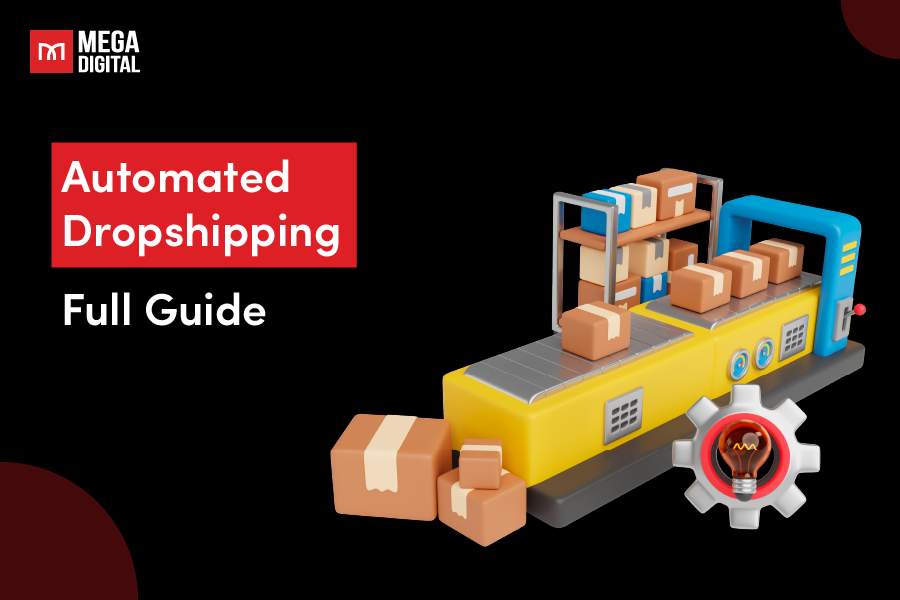
8. Keep Customers Coming Back
Getting a new customer is great, but turning them into a repeat customer is where the magic happens.
Here’s what I do:
- Offer loyalty programs using tools like Smile.io. Customers love earning points that they can redeem for discounts.
- Send personalized follow-up emails. A simple “Thanks for buying!” email can go a long way. If you can suggest complementary products, even better.
- Be quick with customer service. Tools like Zendesk help me respond to inquiries within 24 hours or less.
Pro Tip: Treat your customers like VIPs. Happy customers leave great reviews, and great reviews bring in more sales.
9. Track Your Numbers
You can’t improve what you don’t measure. Keeping an eye on key metrics helps you figure out what’s working and what’s not.
What I track:
- Conversion Rate (CR): I aim for 2–3%. If it’s low, I revisit my website layout or product pages.
- Customer Acquisition Cost (CAC): Keep it below 30% of your Average Order Value (AOV). For example, if my AOV is $50, my CAC should be no more than $15.
- Profit Margins: Use tools like QuickBooks or Shopify analytics to ensure my margins stay within 20–30%.
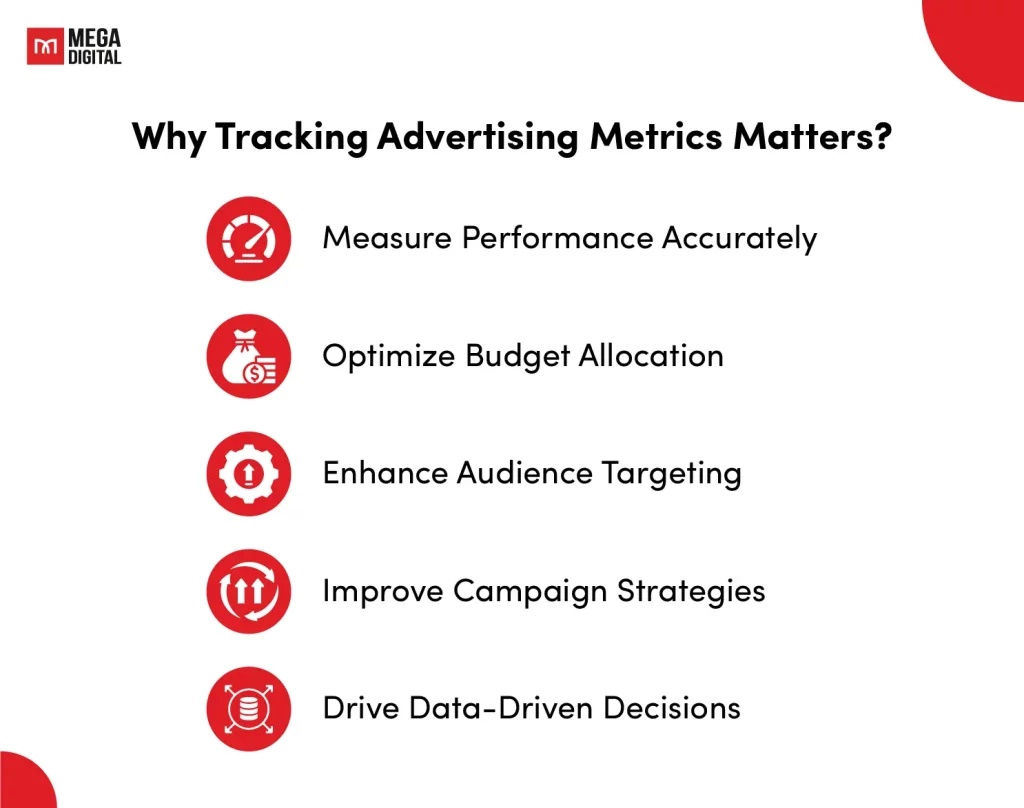
Pro Tip: Block off an hour each week to review your metrics. It’s one of the easiest ways to stay on track.
10. Scale When You’re Ready
Scaling is exciting but tricky. It’s all about growing smartly without overwhelming your resources.
How I scale:
- Increase ad budgets by 10–20% weekly for campaigns that perform well.
- Add complementary products. For example, if resistance bands are selling well, I might introduce foam rollers.
- Outsource repetitive tasks like customer service or social media management. Platforms like Upwork or Fiverr are lifesavers when you’re ready to grow.
Pro Tip: Scaling isn’t a race. Take your time and test every move to avoid costly mistakes.
Is Dropshipping Lucrative: Expectations vs. Reality
Why is it important to understand the common expectations of newbies? Because it will help you avoid making the same rookie mistakes that result in an unprofitable dropshipping business.
Let’s address some of the biggest misconceptions about dropshipping and uncover the truth with Mega Digital’s experts.
The Easy Money Mentality
Expectation: Dropshipping is a quick and easy way to make money.
Reality: If dropshipping were easy money, everyone would be doing it—and succeeding. In truth, most beginners do not fully understand the pros and cons of dropshipping and underestimate how much effort goes into testing products, creating ad campaigns, and managing a store. Think of dropshipping like farming. You don’t just plant seeds and instantly harvest a bounty. You have to water, weed, and nurture your crops—success takes patience and effort.
The Zero Investment Mentality
Expectation: Dropshipping is free to start.
Reality: While you don’t need to buy inventory upfront, you’ll still face costs like website hosting, advertising, and tools to run your store efficiently. Let’s look at some realistic startup costs:
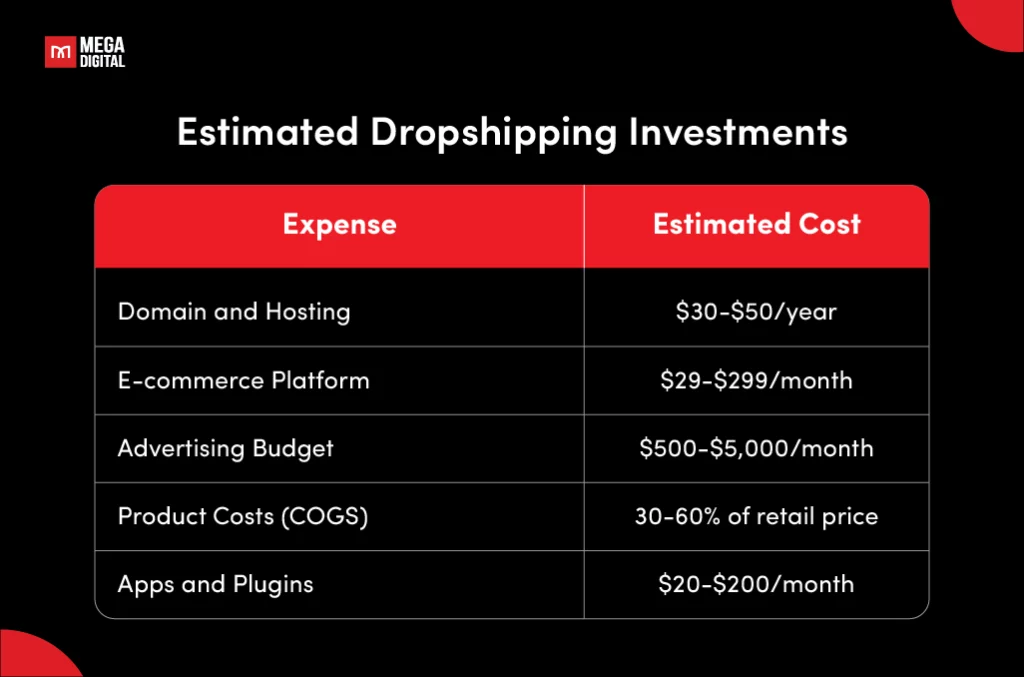
Your largest expense will likely be advertising. Without a budget to test and scale your campaigns, your store won’t gain traction.
The Worry-Free Mentality
Expectation: The supplier handles everything, leaving you to focus on marketing.
Reality: While suppliers handle inventory and shipping, you’re still the face of the business. Customers will come to you with complaints about delayed shipping or defective products. For example, shipping times from China to the US via ePacket average 15–30 days. In a world where Amazon offers two-day shipping, this can lead to unhappy customers unless you manage their expectations.
>>> Read more: AliExpress Shipping Time: How Long Does It Really Take?
The No Branding Mentality
Expectation: Branding isn’t necessary—just sell trending products, and people will buy.
Reality: Dropshipping without branding is like trying to sell lemonade from a stand with no sign. Branding creates trust, and trust drives sales. In 2025, private label dropshipping is expected to dominate, as dropshippers will be increasingly investing in professional branding, custom packaging, and cohesive store designs that make their business stand out.
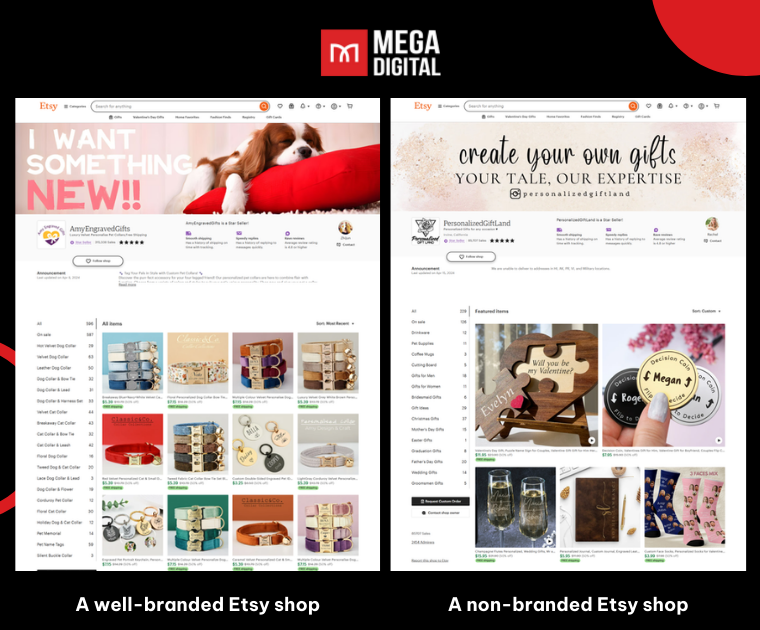
Final Verdict: Is Dropshipping Really Worth It?
So, is dropshipping profitable in 2025?
I know what I’m about to tell you will make you feel as if you’re in a therapy session and not a business guide.
And yes, you’re guessing right—there’s no one-size-fits-all answer to this question. It depends on your expectations, strategy, and willingness to put in the work. If you’re entering dropshipping with a “get-rich-quick” mindset, you’ll likely be disappointed.
But if you approach it as a legitimate business, focusing on creating value for customers, building a brand, and continuously learning, dropshipping can be both lucrative and rewarding.
Running a dropshipping store isn’t a walk in the park—it’s more like running a marathon. There are hurdles, detours, and moments when you’ll want to quit. But with persistence, smart decisions, and a touch of creativity, you can turn your dropshipping dream into a profitable reality.
Wrap Up
So, is dropshipping worth it for you? That’s a decision only you can make. If you’re ready to commit to the journey, Mega Digital is here to guide you with expert advice and advertising solutions tailored for e-commerce success. Let’s build something great together!






